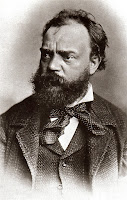 |
| Image from http://upload.wikimedia.org/wikipedia/commons/f/fb/Dvorak1.jpg |
Antonin Dvorak was born in Nelahozeves (a Bohemian village near Prague in the Austrian Empire, now Czech) in 1841, where he lived for most of his life. As a composer it was definitely clear he was inspired by Czech traditional music as he often used the form of Slavic folk dances, for example in his Slavonic Dances. Dvorak was a romantic composer. The romantic era was when composers began to show lots of emotion and expression in their works. This was around the same time as revolutions and uprisings were happening across Europe. In the Czech Republic in the 19th Century the ideas of the French revolution and nationalism grew to be very important and in 1848 there was a revolution.
In 1892 Dvorak moved to New York where he became the National Conservatory of Music director. One of his aims of visiting the country was to find out more about American music. In particular, he took a strong interest in African American and American Indian music. While there, he wrote his Symphony no. 9 - "From the New World". He also composed the "American" String Quartet no. 12 in F Major, the String Quintet no. 3 in E flat Major, the Cello Concerto in b minor, Humoresque in G flat major and a Sonatina op.100 in G Major for violin and piano. It's said he took up a definite American style in these works.
Overall, Dvorak is a prime example of a composer who's style was inspired by where he lived.